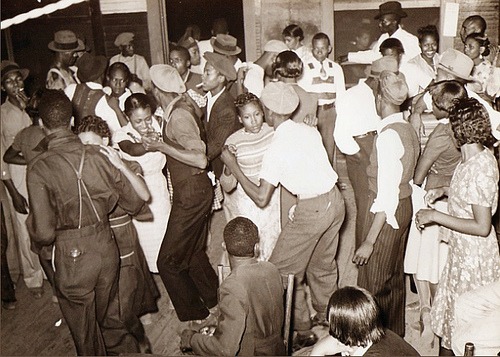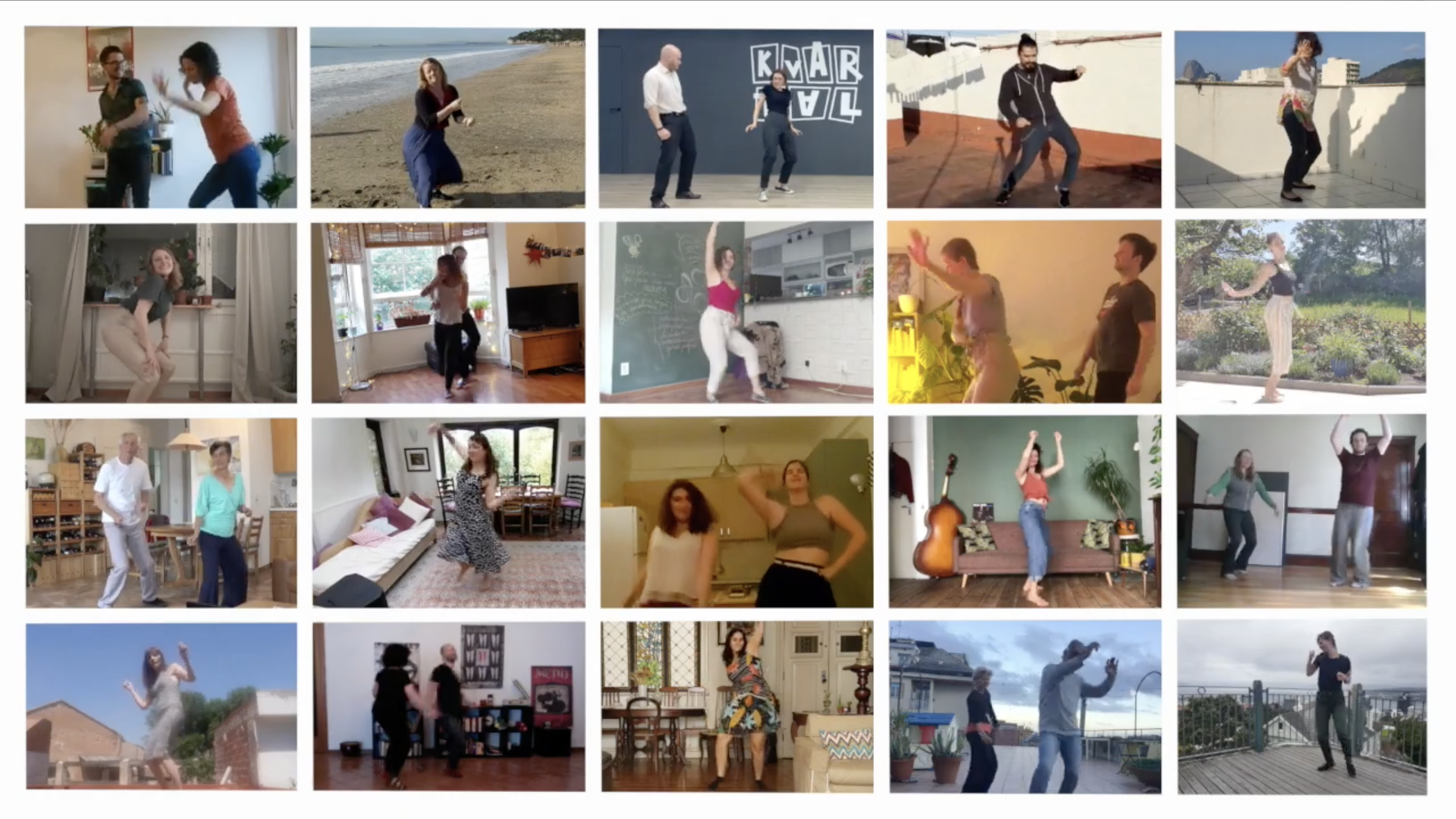This article aims to briefly explore the meaning of vernacular dance, referring mainly to two books: ‘Steppin on the Blues’ by Jacqui Malone and ‘Jazz Dance’ by Marshall and Jean Stearns. More books are listed at the end of the post.
What Is Vernacular Dance?

According to our good friend, Wikipedia, Vernacular dances are‘dances which have developed naturally as a part of everyday culture within a particular community. In contrast to the elite and official culture, vernacular dances are usually learned naturally without formal instruction.’ [1]
In ‘Jazz Dance’ by Marshall and Jean Stearns vernacular is described as “native and homegrown”. [2]
In ’Steppin on the Blues’, Malone explains that vernacular dance “derives not from the academy but from the farms and plantations of the south, slave festivals of the north, levees, urban streets, dance halls, theatres and cabarets. It is constantly changing. The changes, however, always reflect an evolving tradition and vital process of cultural production.”[3]
Ralph Ellison defines ‘vernacular’ in his book ‘Going to the Territory’ as:
“I see the vernacular as a dynamic process in which the most refined styles from the past are continually merged with the play-it-by-eye-and-by-ear improvisations which we invent in our efforts to control our environment and entertain ourselves. And this not only in language and literature, but in architecture and cuisine, in music, costume, and dance, and tools and technology. In it the styles and techniques of the past are adjusted to the needs of the present, and in its integrative action the high styles of the past are democratized…” [4]
Characteristics Of African American Vernacular Dances
Both ‘Jazz Dance’ (Stearns) and ‘Steppin’ on The Blues’ (Malone) explain that African-American vernacular dance is a blend of Central African dance, West African dance and European dance mixed together in an American environment.
The dances born from African American culture are as varied as the culture itself, but it is commonly agreed that they all share certain traits and characteristics. Malone describes these as “improvisation and spontaneity, propulsive rhythm, call-and-response patterns, self expression, elegance and control.”[5]
It is suggested in ‘Jazz’ that “in general, the European influences contributed the elegance, African influences the rhythmic propulsion” (this is obviously an over-simplification, but gives you an idea).[6]
We will explore each of these characteristics in more detail in future blog posts…
Dances From Africa Becoming Worldwide Dance Crazes
African American vernacular dance created many world-wide dance crazes, such as the Charleston, the Lindy Hop, and the Twist. Check out this TED Ed video by Camille Brown, on the history of African American social dances:
In Jazz, Stearns explains: “A few years ago, watching films of West African dancing… the writers saw the Ibibio of Nigeria performing a shimmy to end all shimmies, the Sherbro of Sierra Leone executing an unreasonably fine facsimile of the Snake Hips, and a group of Hausa girls near Kano moving in a fashion closely resembling the Lindy or Jitterbug.”[7]
Frederick Kaigh exclaims that “The children of Africa were doing the Charleston before Julius Cesar had so much heard of Britain, and they still are”.[8]
Sadly the true forms of these dances never really made it into the lime-light. In ‘Jazz’, they explain what I would refer to as a ‘white-washing’ of the dance, quoting Roger Pryor Dodge as saying: “Sadly enough, out of this whole dance mania, none of it developed into the professional stage dance… while Lindy Hoppers stood on the side lines, a new breed of dancer, fortified with ballet and modern dance training, took over show business and danced to some form of jazz music. The new dance has none of the style, refined or not, of the Negro dance. With it’s few movement derived from jazz it became a choreographer’s idea of what dancers with ballet and modern training should do to jazz”.[9]
Blues Dancing Outside Of African-American Cultures
Blues dance as we know it (the international social dance scene as opposed to the communities who dance blues in their homes and in bars in the USA) has now become a ‘taught’ dance – the opposite of a ‘vernacular’ dance. It is something we attend classes to learn. This ‘formal instruction’ is inevitable when many / most of the people dancing in the social blues dance scene are not from African-American heritage. We are not exposed to the dance and the tradition in our everyday lives, and therefore if we want to dance this dance, we have to actively seek out a class to learn it. And although this new way of learning the dance is now widely accepted we need to be careful that we don’t let the way in which we learn affect too deeply the values of the dance itself.
“Albert Murray calls the African American public dance a ritual of purification, affirmation and celebration. It helps drive the blues away and provides rich opportunities to symbolically challenge societal hierarchies by offering powers and freedoms that are impossible in ordinary life. At a dance, anyone with the right moves may become king or queen of the floor.” [10]
According to Malone “Black dance breaks down barriers of gender, age, sex, region and class” [11]. It “is a source of energy, joy and inspiration” and “a way to lighten work, teach social values, and strengthen institutions” and “teaches unity of mind and body and regenerates mental and physical power”[12].
When you read these qualities it’s easy to understand why people worldwide have fallen in love with blues and other African-American dances. African-American vernacular dances provide something that people from all cultures worldwide are craving, are in need of, and can learn from. However, if “African American vernacular dance embodies African American values”[13], then it is vital that we learn, understand and honour these values. Not just values of the past, but current values important to the African American and Black American community today.
A Final Note, Inspired By Dr Christi Jay Wells
We attended a lecture by Dr Christi Jay Wells at BluesSHOUT 2018 in Chicago about ‘Blues and the African Diaspora’. I want to finish this post by passing on some of what Dr Wells said…
…Blues is a living tradition shaped by historical and contemporary movement and migration. As white people dancing this dance we need to honour the roots, but we also need to be careful not to ignore the current, living black culture, and more importantly, black people. Blues culture cannot be frozen in history. When, as white people, we choose to blues dance we are choosing to participate in a living tradition and a living culture; we need to be good guests in this tradition.
Related Reading
As with all our blogs, we have only been able to scrape the surface of this topic. There is so much more to learn about vernacular dances. But luckily there are many excellent books that dig deeper into this subject…
– Steppin’ on the Blues: The Visible Rhythms of African American Dance by Jacqui Malone
– Jazz Dance: The Story of American Vernacular Dance by Marshall and Jean Stearns
– Black Dance From 1619 to Today by Lynne Fauley Emery
– Jookin’: The Rise of Social Dance Formations in African American Culture
Footnotes
[1] https://en.wikipedia.org/wiki/Vernacular_dance
[2] Jazz Dance by Marshall and Jean Stearns. Page xvi
[3] Steppin’ on the Blues by Jacqui Malone. Page 2
[4] Quoted by Malone in ‘Steppin’ on the Blues’, page 2
[5] Steppin’ on the Blues by Jacqui Malone. Page 2
[6] Jazz Dance by Marshall and Jean Stearns. Page xvi
[7] Jazz Dance by Marshall and Jean Stearns. Page 13
[8] Frederick Kaig ‘Witchcraft and Magic in Africa’ 1947, p21. Quoted in ‘Jazz Dance’ on page 13.
[9] Jazz Dance by Marshall and Jean Stearns. Page xvii
[10] Steppin on the Blues by Jacqui Malone. Page 1
[11] Steppin on the Blues by Jacqui Malone. Page 4
[12] Steppin on the Blues by Jacqui Malone. Page 24
[13] Steppin on the Blues by Jacqui Malone. Page 7




